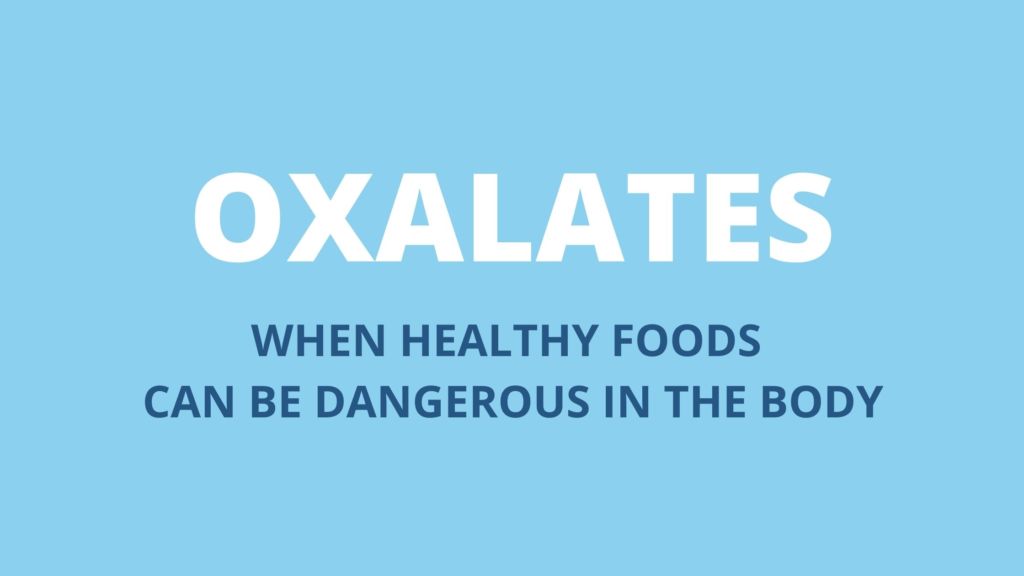Are Oxalates Preventing You From Seeing Results?
Are you working with a client or patient and they are not seeing the improvements that they should be? Maybe oxalates are preventing your client from seeing success.
You have a client or patient that you’ve been working with…let’s call him Jamie. Even though Jamie is doing everything you’re advising, he is nowhere near a picture of perfect health.

Managing stress? Check. Per your coaching, he has started meditating daily and is doing moderate-intensity exercise most days of the week. You’ve even managed to get Jamie, who was once hooked on social media and all things high tech, to turn off all lights and electronics by 10 p.m.
Eating healthy? Check. Guided by your expertise Jamie has drastically cut down on gluten, refined carbohydrates and sugars. Jamie has even ditched donuts and coffee in the morning and is now drinking green drinks packed with spinach and chia seeds instead.
But despite the dramatically improved diet, the newfound stress-reduction practice and increased exercise, Jamie is still not well.
Even after a few months of this health transformation, Jamie often feels tired or experiences brain fog. And worst of all, he has developed painful kidney stones.

What does this mean? You’re at a loss. Jamie should be thriving by now.
Maybe Jamie’s years of unhealthy eating and other lifestyle factors have created a condition which no amount of meditation and green drinks can overcome. And maybe the healthy foods Jamie is now eating are actually contributing to the stones and other negative symptoms.
There’s one culprit that may reveal why Jamie is still not feeling well…oxalates.
Oxalates are anti-nutrients that interfere with the absorption of minerals, especially calcium and magnesium.
Like lectins, phytates and saponins, oxalates are found in foods that are normally regarded as healthy. Kale, chard, and other leafy greens including Jamie’s favorite morning green drink ingredient–spinach–are all high in oxalates. So are Jamie’s chia seeds.
Jamie’s high oxalate content and the inability to pass the oxalic acid through the urine means that Jamie isn’t properly absorbing calcium and magnesium, as well as other minerals such as zinc and iron.
For Jamie, this can mean not only possible kidney stones, brain fog, and fatigue…but a long list of other potential problems, including fibromyalgia, frequent urinary tract infections, inflammatory bowel disease, hypothyroidism, osteoporosis, asthma and several other symptoms that arise from too many oxalates.
There’s a good chance that eventually in your practice, you’ll have a client like Jamie. You’ll be scratching your head as to why, despite the dramatic positive lifestyle choices you’ve helped instill in your client, the client isn’t getting better. In fact, they could be getting worse.
Become an expert on oxalates

How do oxalates affect the body?
Oxalates can form sharp, knife-like crystals in the body. These crystals can lodge in tissues and organs, causing pain and inflammation.
Most people can handle low to moderate amounts of oxalate accumulation in the body. But problems like kidney stones develop when there are excessively high levels of oxalates.
The good news is that boiling sources of high dietary oxalates can reduce the amount of accumulated oxalic acid in the body. Still, if you have a client like Jamie, you’ll want to recommend they avoid sources that are high in oxalates.

What factors contribute to an oxalate problem?
And although a diet high in oxalates can contribute to elevated oxalates in the body, there are several other hidden factors that may explain why oxalates are not able to be eliminated through the urine, including:
- Antibiotic use and subsequent gut dysbiosis
- Yeast and/or fungi overgrowth
- Micronutrient deficiencies
- Fat malabsorption
- Leaky gut or gut inflammation
- Genetics
There is no way of avoiding oxalates. Our bodies make it as an end product of metabolism (especially of the amino acids glycine and serine, and vitamin C). Even if you coach your clients to eat a zero oxalate diet, your clients will still have oxalic acid in their system.
The human body, as a result of normal metabolic processes, creates oxalates. The majority of it should be excreted through the urine. It’s likely most of your clients will show no negative symptoms with low or moderate oxalates accumulated in their bodily tissues, but every now and then, you’ll come across a client like Jamie, who for various reasons also mentioned above, will present with high oxalate build-up.
Will you know what to do when your client has high oxalates?

Learn what you need to know about oxalates to help them
Besides potentially creating sharp and painful knife-like crystals, oxalates are bad news for your clients because they can also get into the cells and affect the mitochondria, where ATP is produced. This oxalate accumulation in the mitochondria can interfere with ATP production, a likely reason why someone with high oxalate accumulation will often feel sluggish.
Oxalates are produced during normal cell metabolism, but to a greater extent when certain nutritional deficiencies or genetic issues affecting particular enzymes are present. The majority (80-90%) of urinary oxalate is produced endogenously, created within the cells.
Yet another reason why oxalates can do drastic damage to your clients’ health is because they bind with heavy metals such as mercury and trap them in the tissues, preventing their release from the body.
In a normal functioning human body, oxalates are eliminated in three different ways. First, by forming insoluble calcium oxalate crystals. Calcium binds with oxalic acid, so it can then be eliminated in the stool. Second, by processing it through the kidneys and then excreting it in urine. And third, by having beneficial bacteria in the gut that degrade the oxalates.
Got Oxalobacter formigenes? Chances are, your client, like Jamie, doesn’t have enough of this bacterial strain to gobble up oxalates in the gut.
Just one single course of antibiotics can significantly decrease or wipe out the population of Oxalobacter formigenes for months, years, or even indefinitely!

High oxalates is more common than you might think!
If you’re a health coach in the USA, this statistic reveals why it’s very likely you’ve already had or will have a client like Jamie: a 2012 Wake Forest University study found that the percentage of people who have O. formigenes in their digestive tracts is only 38% in the states, compared to 77% in Korea.
The study also concluded strains of O. formigenes were particularly sensitive to popularly-prescribed antibiotics such as azithromycin, ciprofloxacin, doxycycline, gentamicin, and tetracycline.
When you take the Functional Diagnostic Nutrition’s oxalate advanced training course, you’ll learn when to suspect an excess oxalate problem; when to test for excess oxalates; how to test oxalate levels; learn which labs have the most reliable oxalate tests, as well as other diagnostic tests that are particularly useful to run concurrently with oxalate testing.
You can take a chance that you’ll never have a client like Jamie. But considering how many people have gut dysbiosis or have been overprescribed antibiotics, there’s a decent possibility that you’ll have a client with high oxalate at some point.

Will you know how to help them?
Learn more about our Oxalate advanced training course







